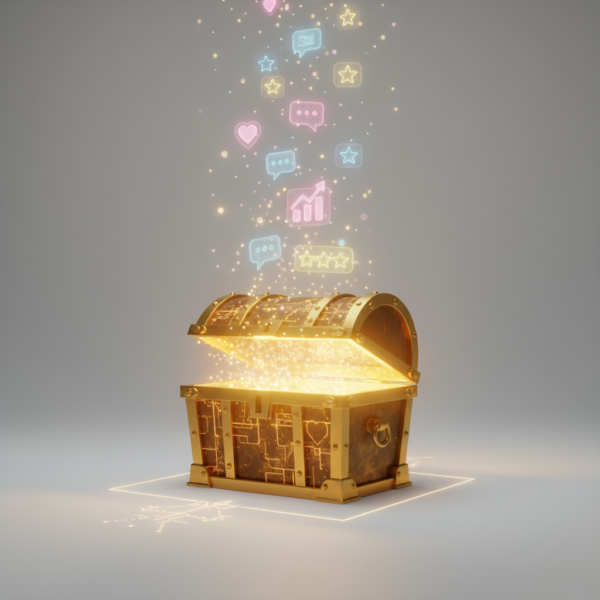You’ve probably heard about companies using gamification to engage customers and increase brand loyalty. But have you been wondering just how effective these gamification campaigns can be?
If you’ve had doubts, then keep reading to see how successful companies have used gamification to get ahead of the game and magnify their reach beyond what they thought possible.
These great gamification examples will remove any doubts you have about the power of gamification.
What makes the gamification ideas successful?
Today, video games are more popular than ever and are incredibly effective at grabbing people’s attention. Gamification capitalizes on this by integrating gaming mechanics into traditional non-gaming contexts. For example, the popular navigation app Waze uses gaming elements to encourage users to share traffic information.
This is just one example of gamification, but it has a wide range of uses, from capturing the attention of potential customers to making education fun through gamified learning.
Read more
Best gamification ideas
Here are twelve of Adact‘s best gamification examples in action.
1. Duolingo – Gamification in education
Duolingo is one of the most successful examples of gamification in education. With Duolingo, users are rewarded with experience points and achievement badges for their learning progress.
Users can also achieve “streaks” when they use the app consistently. Other game elements such as leaderboards, a progress bar, and virtual currency make language learning more fun and motivate users to make progress.
Results:
- 19 million daily active users by 2023
- Introducing badges increased in-app purchases by 13%
- Improved engagement through the progress bar and streak system
2. Microsoft – Gamification in the workplace
Microsoft used sales gamification ideas in its call centers to improve the productivity of call center staff. The tech company used leaderboards and challenges to reward staff members for their positive performance. This gamification was successful at keeping employees engaged and motivated.
Results:
- Productivity increased by 10%
- Employees started offering additional products
- 12% reduction in absenteeism
- Improved customer satisfaction
3. Euronics and Kaubamaja – Gamification in e-commerce
Euronics launched a branded game inspired by Candy Crush to generate awareness for their JBL Live Pro 2 headphones. The familiar game elements evoked a competitive spirit and motivated users to visit a Euronics store and purchase the product.
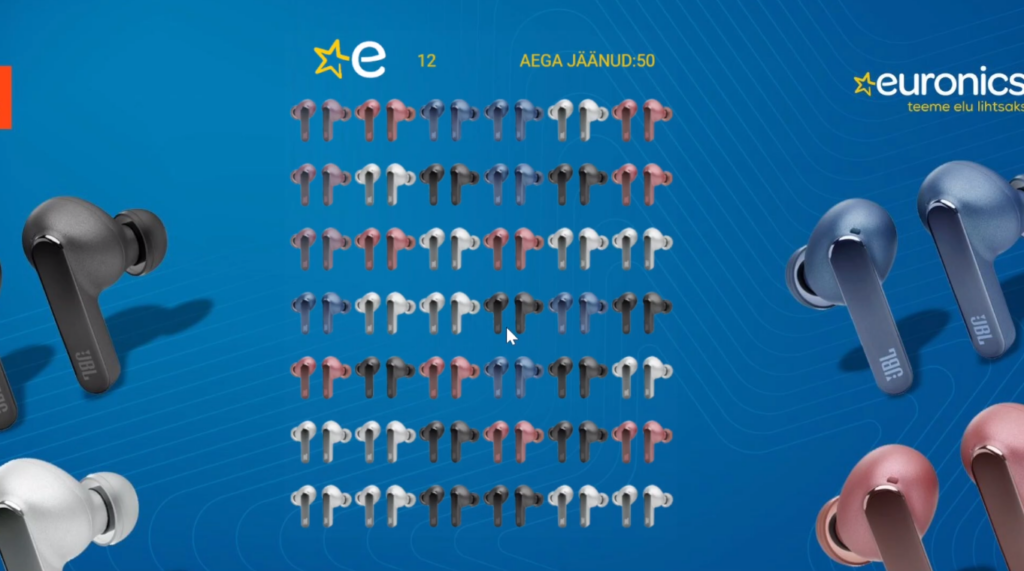
The campaign used familiar gamified elements to generate more engaged users. The addictive nature of the contest kept users motivated and helped them accumulate loyalty points.
At the same time, Euronics could show customers the different styles and colors available for their headphones through the game, making this one of the best sales gamification ideas.
Results:
- 6,100 unique page visitors
- Over 54,000 games started
- Over 3,300 unique leads
- 16.2 minutes average engagement time (one-minute average gameplay with a single player playing the same game approximately 16.2 times)
Kaubamaja is an Estonian department store that brought eCommerce gamification into the mix when it created its Shopping Race game to promote a flash sale. The game mechanics in this drop game are a great example of how a simple and fun campaign can get people talking.
The main goal of the game was to have customers earn real-world rewards through some healthy competition. This great gamification example proved highly addictive and its action-based gameplay resulted in longer engagement times.
Results:
- 10,000 players in one day
- 99% game completion
- 150-second engagement per player
4. Bite, A1 Slovenia and Tele2 – Gamification in telecommunications
Bite is a Lithuanian telecom company that was looking for an out-of-the-box way to collect customers’ emails in preparation for their Black Friday promotion. In this example, telecom gamification software helped them gather customer data and encouraged users to complete tasks and engage with the company.
Their Match 3 Black Friday campaign had a minimalistic design and it used prizes and a leaderboard to register check-ins. However, the results were anything but minimal.
Results:
- 567,077 visits
- 488,307 games started
- 98.9% completion rate
- 14% bounce rate
- An average of 51 gameplays per player
Telecommunications company A1 Slovenia created the Moj A1 app to allow users to easily manage their own accounts. The app allows customers to track data consumption, talk minutes, and other expenses, as well as pay bills and activate new plans.
After looking at some gamification examples in marketing, A1 Slovenia decided to make a trivia game and added three games to the app to increase the number of users and frequency of use. The idea was to drive regular visits to the app by creating a natural desire to participate in trivia games and earn points. And they ended up doing just that.
Results:
- Increased monthly active users by 10% in 3 weeks
- A steady increase in active app users all year long
- 20,000 unique leads
- 3-question trivia led to a one-minute interaction with branded content
After checking in with Adact on how to make a wheel of fortune game, Tele2 decided to go for it.

The telecommunication company was looking to grow brand awareness and capture new leads through the fun and excitement of a wheel of fortune campaign, and in the end, the results were promising.
Results:
- 10,069 leads
- 18,683 gameplays over 2 weeks
5. Adažu and Eggo – Gamification in retail
When Adažu decided to make a Tinder-style swipe game with Adact, they had a few goals in mind. They wanted to present limited-edition products to customers and engage users to popularize their chip brand.
The company was also looking for gamification ideas that evoked a sense of nostalgia and created positive associations with its brand. So they chose a game that presented users with different flavors and allowed them to vote for their favorite by swiping left or right.
Adažu used radio stations, online channels, digital screens, and in-store displays to promote their game. People who heard about this fun game quickly voted for their favorite chip flavor.
Results:
- 3,836 people voted on the first day
- “Chips Tinder” trending on social media
- Significant improvement in customer loyalty
In another one of our gamification retail examples, Estonian egg production company Eggo employed gamification techniques in their branded Candy Crush game to maximize advertising.
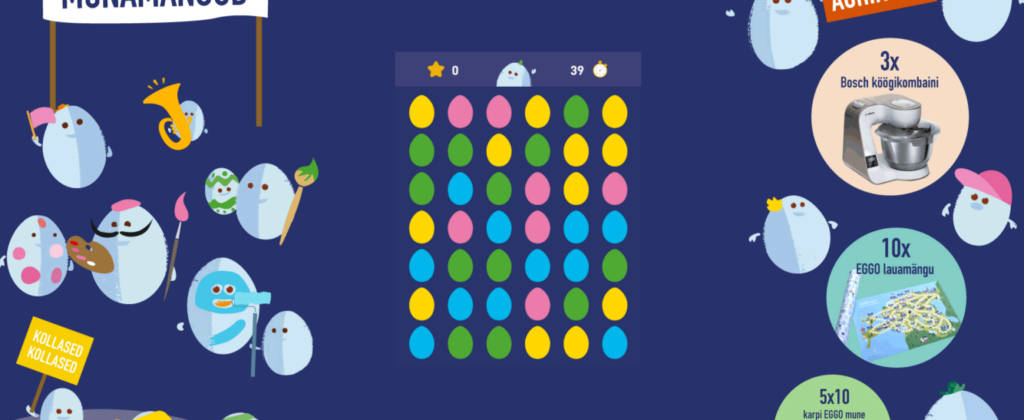
The sales teams settled on a Match 3 game and called it Eggo World. Their goal was to strengthen the customers’ connection between their product and brand. The game ended up being one of the most successful Easter marketing ideas, significantly boosting engagement among customers and other users.
Results:
- Engagement with 5,000 people in 3 weeks
- 190,000 game plays
- The most active player played 4,900 times
- The average player played 38 times
Gamification makes it easy to boost real-life sales and receive instant feedback. Tallink Grupp transport services know this and are no strangers to using sales gamification examples as a part of their campaigns. This time their goal was to target their online store’s younger audience.
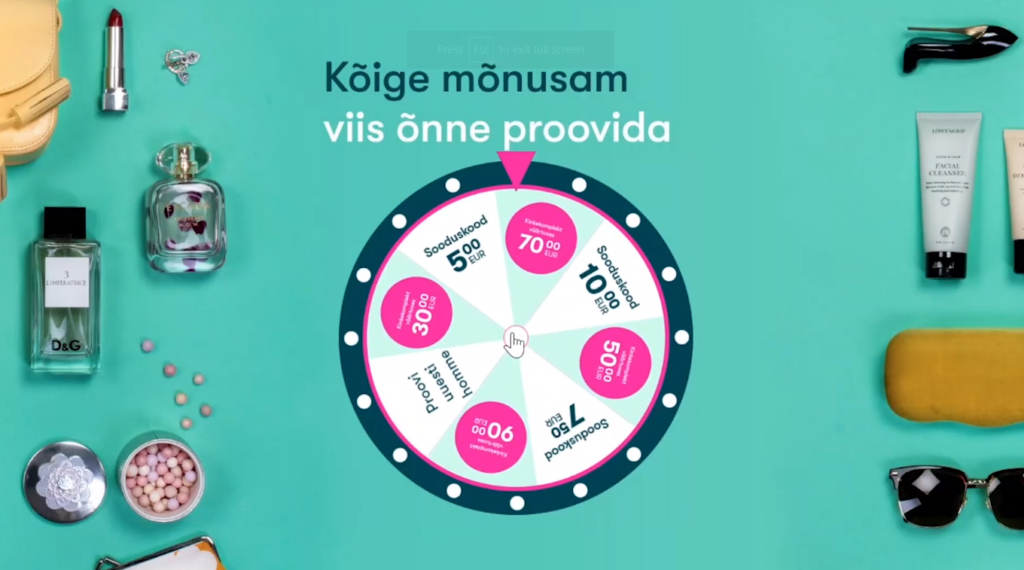
Their wheel of fortune campaign appealed to a younger audience and proved as an effective way to spread brand awareness among players. The point of the game was to give out coupon codes to customers in hopes they would use them. Each player was limited to one spin per day, which kept them coming back for more.
Results:
- 3,238 unique leads
- 5,315 gameplays
- 98.81% click-through rate
Orkla successfully used gamification to promote their new food product Topz. In this gamification example, Orkla implemented a Match 3 game element to take advantage of customers’ short attention spans and need for instant gratification.
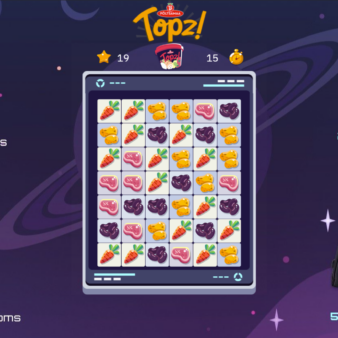
They recruited social media experts to spread the word about their campaign on channels like Facebook and Instagram. During the one month they ran their campaign, they saw a massive increase in potential customers interacting with their brand.
Results:
- 931,342 overall reach
- 409,871 gameplays
- 16-minute average engagement
- 16% bounce rate
- 96% completion rate
6. Atomic Wallet – Gamification in crypto

Our list of gamification marketing examples also includes crypto companies that use gamification. Atomic Wallet is an online wallet that helps users store, manage, and exchange 500 cryptocurrencies. They decided to make their own Jeopardy game with Adact to create a successful marketing campaign.
The goal of this Jeopardy game was to reward users with tokens for their knowledge of Polygon crypto. Those tokens could then be used to win prizes and other rewards. This example of gamification ended up being a great success for both the game winners and the company!
Results:
- 246,000 unique players
- 95% game competition
- Optimal user engagement
Check out our Jeopardy trivia questions collection for different categories.
7. Swedbank and Creditstar – Gamification in finance and banking
Some of the best gamification examples also come from industries like finance. In the first of our gamification in banking examples, Swedbank was looking for a way to satisfy its customers and help them learn how to save for a better future. They wanted to strengthen customer loyalty programs through gamification and get people excited about winning prizes during the holidays.
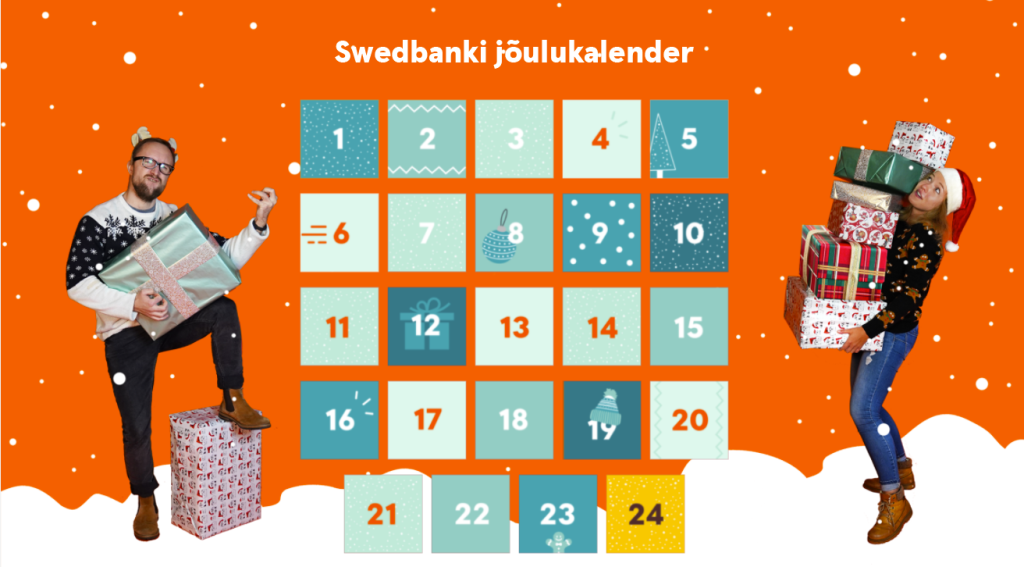
Swedbank used Adact software to create an advent calendar with prizes behind every door. And since advent calendar games are a great way to implement gamification around the holidays, their campaign was a great success!
Results:
- 100x more engagement
- 140,000 gameplays in 24 days
- 24,000 potential new customers
In another one of our gamification campaign examples, CreditStar came to Adact to create a holiday gamification campaign. They had two goals in mind when building their gamification campaign:
- let users have fun
- to remind people about their products and offers.
Holiday campaigns are all about fun. And what’s more fun than smashing as many pumpkins as possible in 60 seconds? That’s why CreditStar teamed up with Adact, one of the top gamification companies, to make their Halloween smash game a smashing hit.
Results:
- 20% customer conversion rate (with a call-to-action button at the end of the game)
8. KPMG – Gamification in employee engagement
KPMG created a game called Globerunner to teach staff about their organization’s capabilities, helping them better serve customers and achieve organizational objectives.
In the game, employees travel around the world and answer questions about the firm’s capabilities. Players get points for correct answers, unlock achievements and missions, and compete on a global leaderboard. Used in over 80 countries by over 100,000 employees, Globerunner is one of the best gamification examples for employee engagement.
Results:
- 89% of employees said the app gave them a positive impression of KPMG
- 71% of users better understand how to solve client challenges
- 24% improvement in awareness of KPMG’s capabilities
9. Marriott Bonvoy – Gamification in customer loyalty
Marriott used gamification in their loyalty program to encourage repeat visits and promote brand loyalty.
The hospitality company created Marriott Bonvoy, a loyalty program that rewards members with points and achievement badges. As members make more purchases, they level up their membership and gain more benefits.
Results:
- Improved customer loyalty
- Motivated repeat purchases
- Promoted engagement across digital channels
10. Waze – Gamification in apps
One of the best gamification app examples is Waze. As a navigation App, Waze’s main goal is to get users to their location as fast as possible. They achieved this through gamification.
Waze features a gamified map and avatars that make traveling more fun. It also implements a reward system that gives users achievements for interacting with other users, making map edits, and more.
Results:
- Over 130 million active users
- Increased user participation
- Improve community contributions
Gamification ideas FAQ
Where can I find easy gamification ideas?
The best place to find easy gamification ideas is through a top gamification company like Adact. Adact has a wide range of games to choose from, which can give you plenty of ideas for your gamification campaign.
How can I gamify my idea?
Book a demo with Adact to learn how to bring your gamification idea to life. With Adact, you don’t need any coding knowledge to gamify your idea. The software is easy to use and the Adact team will help you implement your gamification campaign to help you reach your gamification goals.
Where can gamification be used?
Gamification has a wide range of applications. Business gamification examples include gamification for increasing sales and marketing. Examples of gamification in the workplace include employee training, onboarding, and employee engagement.
There are also many gamified learning examples, as gamification is effective at promoting engagement, concentration, and motivation in learning.
How effective is gamification?
Gamification can be a highly effective strategy when implemented thoughtfully and tailored for a specific context and audience. When using the right gamification software, gamification can increase engagement, motivate users, develop users’ skills, and enhance social interaction and collaboration.
What are some fun gamification ideas?
Some fun gamification ideas include contests, challenges, trivia, badges, leaderboards, a virtual reward system, or even gamified storytelling. All these gamification examples exist in gamification in sales, marketing, education, training, and more.
Turn your gamification idea into a success story
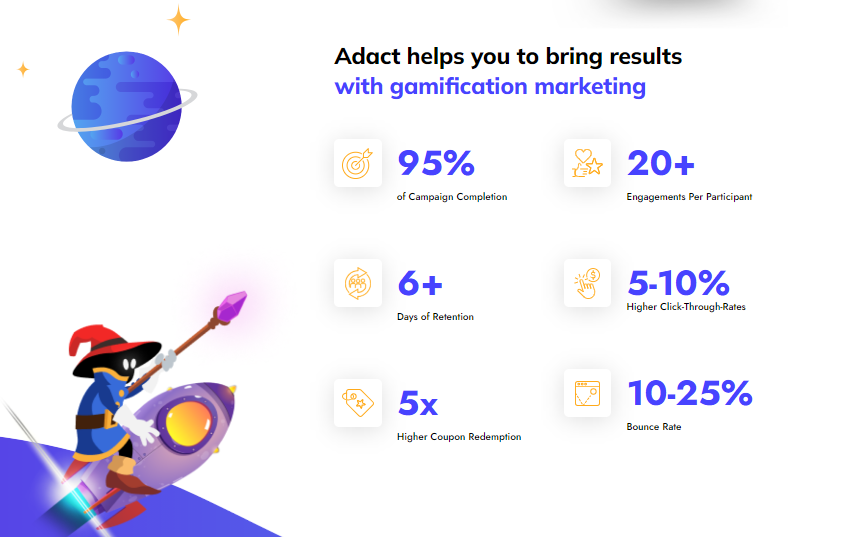
Now that you’ve witnessed the success of gamification, it’s time to join the fun. Adact gamification software is the best way to add exciting and simple game elements to your campaign. And it requires no coding knowledge!
Gamification with Adact is the perfect antidote for your audience’s short attention span. By putting your gamification ideas into reality, you can strengthen brand recognition, watch your leads skyrocket, and boost customer satisfaction. Gamification with Adact can also help make learning fun, which is great for team building, corporate training, and organizational productivity.
Just take a look at some of the best gamification examples in education, business, and employee engagement to look for inspiration. Many companies have experienced incredible success by integrating game elements like leaderboards, badges, and achievements!
With Adact, you can use gamification to increase user engagement and magnify your reach beyond what you thought possible.
Book a free demo with Adact today and we’ll help you put your gamification ideas into action!


